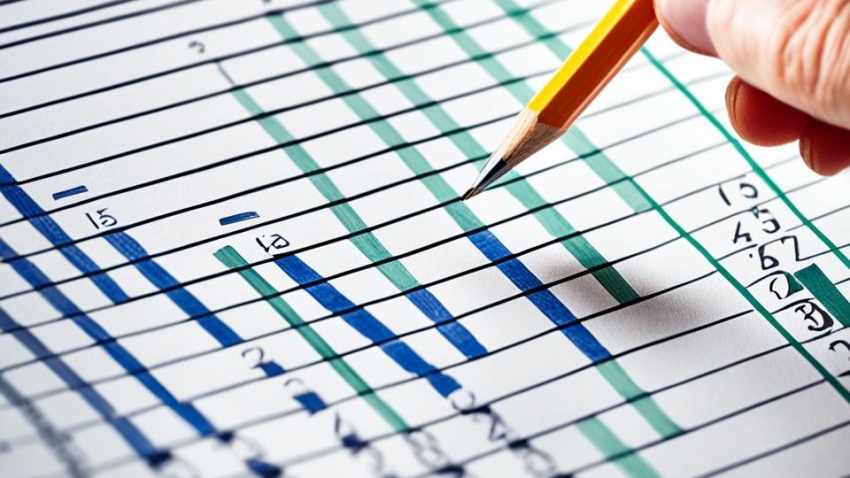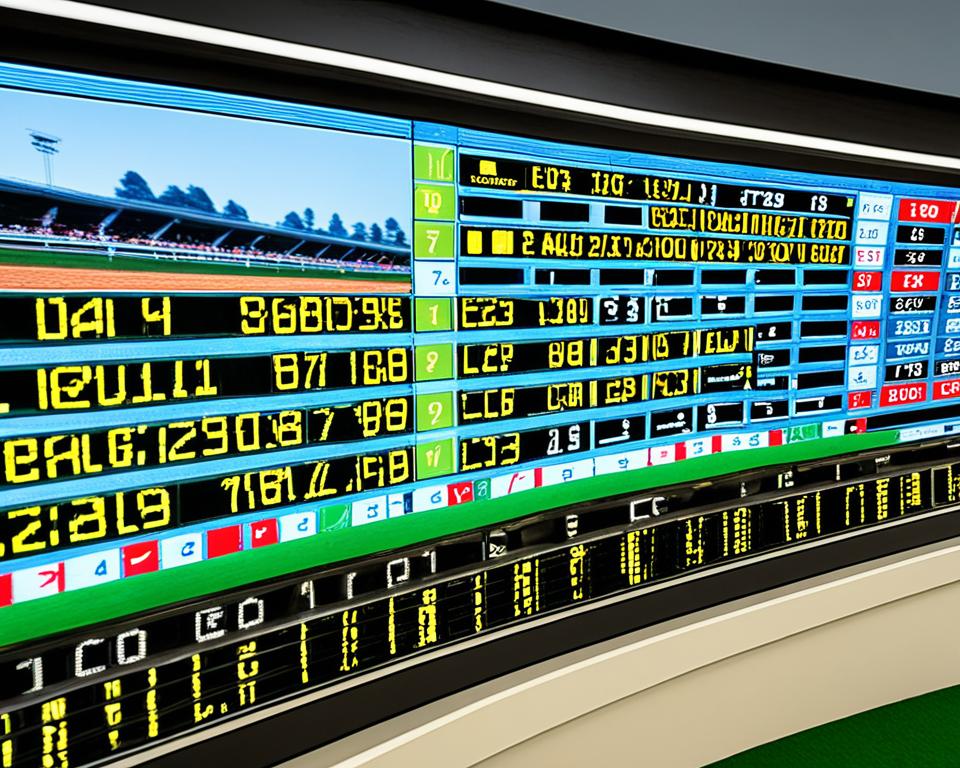
Understanding Horse Racing Odds Calculation
When it comes to horse racing, understanding how odds are calculated is essential for making informed betting decisions. Horse racing odds provide valuable insights into the probability of a horse winning, and by deciphering these odds, bettors can identify value bets and increase their chances of success.
In this comprehensive guide, we will dive into the world of horse racing odds and explore the intricacies of their calculation. Whether you’re a seasoned bettor or a novice looking to enhance your knowledge, this article will provide you with valuable insights into horse racing odds and equip you with the tools to make more accurate betting predictions.
Read interesting things at : revolutionbookscamb
Key Takeaways:
- Understanding how horse racing odds are calculated is crucial for successful betting.
- Horse racing odds reflect the probability of a horse winning a race.
- Factors such as race conditions, horse form, jockey skills, and the betting market influence horse racing odds.
- Bookmakers play a key role in setting horse racing odds, considering various factors to determine the probability of a horse winning.
- Horse racing odds can be presented in decimal or fractional formats, each with its own unique calculation.
The Basics of Horse Racing Odds
When it comes to horse racing betting, understanding the basics of odds calculation is essential. By grasping the formula used by bookies to calculate these odds, you can make more informed betting decisions and increase your chances of success.
So, how are horse racing odds calculated?
Bookmakers use a specific formula to determine the odds for each horse in a race. The horse betting odds formula combines several factors to estimate the probability of a horse winning. These factors include historical performance, horse form, jockey skills, and the overall betting market.
Calculating horse racing odds
The calculation of horse racing odds involves determining the specific probability of each possible outcome and assigning a corresponding odds value. The odds indicate the potential payout the bettor will receive if their selection wins. The higher the odds, the higher the potential payout, but the lower the probability of winning.
“The horse betting odds formula incorporates multiple variables, making it a comprehensive method for predicting odds and outcomes.”
To calculate horse racing odds, bookmakers assess historical data, consider the current form of the horse and jockey, analyze the race conditions, and evaluate the impact of the betting market. These factors are weighed and processed using the horse betting odds formula, resulting in the odds provided to bettors.
Understanding the formula’s impact
By understanding the formula used to calculate horse racing odds, you can gain insights into the bookmakers’ perspective and their assessment of each horse’s chances of winning. This knowledge can help you identify potential value bets where the odds offered by the bookmaker are higher than the true probability of the outcome occurring.
Furthermore, understanding the basics of odds calculation allows you to analyze the odds provided for different horses and races. You can spot trends, identify horses with favorable odds, and make more informed betting decisions based on your analysis.
To illustrate the process of calculating horse racing odds, let’s take a look at a hypothetical example:
| Horse | Probability | Odds |
|---|---|---|
| Horse A | 25% | 3.00 |
| Horse B | 40% | 2.50 |
| Horse C | 35% | 2.85 |
Based on the horse betting odds formula, the bookmaker has estimated the probability of Horse A winning at 25%, Horse B at 40%, and Horse C at 35%. These probabilities are converted into odds, with Horse A having odds of 3.00, Horse B at 2.50, and Horse C at 2.85.
Understanding the relationship between probability and odds is crucial for making well-informed betting decisions. It allows you to compare the bookmakers’ estimation with your own analysis and identify discrepancies that may present opportunities for value betting.
Now that you have a solid foundation in the basics of horse racing odds, you can proceed to explore the various factors influencing these odds and gain a deeper understanding of how bookmakers operate.
Factors Affecting Horse Racing Odds
Horse racing odds are influenced by various factors that can significantly impact the potential payout. Understanding these factors is key to analyzing and interpreting odds effectively. In this section, we will explore the key elements that affect horse racing odds, including race conditions, horse form, jockey skills, and the betting market.
Race Conditions
Race conditions play a crucial role in determining horse racing odds payout. Factors such as track surface, distance, weather conditions, and class of the race can all affect a horse’s performance. For example, a horse that tends to perform well on a firm turf track may have higher odds if the race takes place on a muddy track. Additionally, races that feature stronger competition may result in higher odds for all horses involved.
Horse Form
Horse form refers to a horse’s recent performance history, including its past races and results. Bettors and bookmakers analyze a horse’s form to assess its current fitness, consistency, and ability to perform well in the upcoming race. Horses with a strong track record and a history of consistent success will often have lower odds, whereas horses with inconsistent or poor recent form may have higher odds.
Jockey Skills
Jockey skills are another significant factor influencing horse racing odds. Experienced and successful jockeys who have a good track record of winning races can impact the odds by increasing the chances of their horse performing well. Conversely, less-experienced or less-successful jockeys may lead to higher odds for their horses.
The Betting Market
The betting market plays a crucial role in determining the odds for horse racing. The amount of money wagered on each horse affects its odds. If a particular horse receives a significant amount of bets, its odds may decrease, while the odds for other horses may increase. The betting market reflects the collective judgment of bettors and can be a valuable indicator of a horse’s potential performance.
By considering these factors – race conditions, horse form, jockey skills, and the betting market – you can gain insights into how odds are determined in horse racing. This knowledge will empower you to make more informed betting decisions and increase your chances of success.
| Factors | Impact on Betting Odds |
|---|---|
| Race Conditions | Affects performance suitability for each horse |
| Horse Form | Indicates recent performance and consistency |
| Jockey Skills | Influences horse performance and outcomes |
| Betting Market | Reflects collective judgment and influences odds |
The Role of Bookmakers in Setting Odds
When it comes to horse racing, bookmakers play a vital role in setting the odds. These odds represent the bookmaker’s estimation of a horse’s likelihood of winning a race. Understanding how bookmakers calculate these odds is essential for any serious bettor. By gaining insight into their perspective and the factors they consider, you can enhance your ability to identify value bets and make more informed decisions.
Bookmakers take into account various factors when determining the probability of a horse winning. One key factor is the horse’s past performance. They analyze factors such as recent race results, finishing positions, and the track conditions to assess a horse’s form and potential for success.
In addition to past performance, bookmakers consider other crucial elements such as the horse’s age, weight, jockey’s skills and experience, and the race distance. These factors give bookmakers a comprehensive view of the horse’s capabilities and help them determine the probability of a win.
The Bookmakers’ Perspective: Balancing Risk and Reward
Bookmakers aim to set odds that reflect the probability of each horse winning while ensuring their own profitability. They carefully analyze all available information, from the horse’s statistics to market trends, to strike a balance between risk and reward.
By offering odds that are attractive to bettors, bookmakers encourage a balanced distribution of bets across all competing horses. This helps them minimize their potential losses and ensure a steady profit margin in the long run.
Bookmakers rely on their expertise, knowledge of the industry, and sophisticated algorithms to calculate odds accurately. They continuously monitor the market, adjusting odds based on the influx of bets and any changes in the horses’ conditions or public sentiment.
It’s important to note that bookmakers’ odds are not a guaranteed reflection of a horse’s true chances of winning. They are influenced by various factors and can differ from the opinions of individual bettors or professional handicappers. Recognizing this disparity allows astute bettors to identify value bets that offer higher potential payouts than the bookmakers’ estimation.
To make the most of the bookmakers’ odds, bettors need to analyze and assess the provided odds with their own insights and strategies. By merging bookmakers’ knowledge with your understanding of the sport and its intricacies, you can gain a competitive edge and increase your chances of success.
| Factors Considered by Bookmakers | Explanation |
|---|---|
| Past Performance | Bookmakers analyze a horse’s previous races, including recent results, finishing positions, and track conditions, to evaluate form and potential. |
| Horse Attributes | Age, weight, breed, and training background are all factors that bookmakers consider when assessing a horse’s chances of winning. |
| Jockey Skills | The jockey’s experience, record, and riding style can influence the bookmakers’ estimation of a horse’s performance. |
| Race Conditions | The track conditions, race distance, and other environmental factors are taken into account to gauge the horse’s suitability for the race. |
| Betting Market | Bookmakers closely monitor the betting market to make adjustments to the odds based on public sentiments and changes in betting patterns. |
Decimal Odds vs. Fractional Odds
When it comes to horse racing odds, two commonly used formats are decimal odds and fractional odds. Understanding the differences between these formats is essential for any serious bettor. Let’s take a closer look at each format and explore a convenient horse racing odds converter that allows you to seamlessly switch between them.
Decimal Odds
Decimal odds are the most prevalent format used globally. They represent the total return a bettor can expect to receive, including their original stake. The decimal odds indicate how much you will win for every unit wagered. For example, odds of 3.50 mean that if you bet $1, you will receive $3.50 in return, including your stake.
Fractional Odds
Fractional odds, popular in the United Kingdom and Ireland, express odds as fractions. The odds are given in the form of a ratio, with the numerator representing the potential profit and the denominator indicating the stake required. For instance, fractional odds of 5/1 mean you stand to win $5 for every $1 bet, plus your initial stake.
Converting between decimal and fractional odds can be challenging for some bettors. However, there’s a straightforward solution to streamline this process. An efficient horse racing odds converter tool can do the calculations for you, allowing you to compare and switch between decimal and fractional odds effortlessly.
By using a horse racing odds converter, you can quickly adapt to different odds formats, giving you greater flexibility and accessibility in your betting strategy. Now, let’s take a closer look at how the horse racing odds converter works:
- Input the odds you have, whether decimal or fractional.
- Select the desired output format, either decimal or fractional.
- Click the convert button.
- Voila! The converted odds will be displayed, allowing you to make informed betting decisions.
This user-friendly tool eliminates the need for manual calculations, saving you time and effort. Whether you prefer decimal or fractional odds, the horse racing odds converter ensures you have all the information you need at your fingertips.
Now, armed with a solid understanding of decimal and fractional odds, as well as a powerful converter tool, you can confidently navigate the diverse world of horse racing betting. Utilize these tools to your advantage and enhance your ability to analyze odds effectively.
Probability and Implied Odds
In the world of horse racing odds, understanding probability and implied odds is crucial for successful betting. By converting odds into percentage probabilities, you can gain valuable insights into the likelihood of a particular outcome and make more informed wagering decisions.
The Conversion Formula
Converting odds into probability involves a simple calculation. To determine the probability percentage, divide 1 by the odds and multiply by 100. Let’s take an example:
You come across a horse with odds of 5/1. To calculate the probability of this horse winning, apply the formula: 1 / (5 + 1) * 100 = 16.67%. This means there is approximately a 16.67% chance of the horse winning the race.
Identifying Positive and Negative Value Bets
Implied odds play a significant role in identifying value bets. When the probability calculated from the odds is higher than the perceived probability of an outcome, a positive value bet may exist. This suggests that the odds offered by the bookmaker are more favorable than they should be.
Conversely, when the probability calculated from the odds is lower than the perceived probability of an outcome, a negative value bet may be present. In such cases, the odds offered by the bookmaker are less favorable than they should be.
Interpreting Implied Odds
By considering the implied odds, you can assess whether a bet offers value or not. If the implied odds are greater than the calculated probability, the bet may provide positive value. Conversely, if the implied odds are lower than the calculated probability, it may be advisable to avoid the bet as it may offer negative value.
Remember, calculating probability and implied odds can help you make more informed betting decisions, but it is not a foolproof method. It is important to conduct thorough research, analyze other factors affecting horse racing odds, and apply critical thinking when evaluating potential bets.
Making Sense of Odds Charts
Odds charts are invaluable tools for horse racing bettors. They provide a visual representation of the odds offered for each horse in a race, allowing you to quickly assess the market and identify potential opportunities. Understanding how to read and interpret these charts effectively is key to maximizing your chances of success.
Key Components of Odds Charts
When examining an odds chart, there are several key components to pay attention to:
- Horse Names: The names of the horses competing in the race.
- Odds: The numerical representation of the odds for each horse.
- Colors or Numbers: Some charts may use colors or numbers to represent odds ranges or favorites.
- Trends: Any upward or downward movement in the odds can indicate shifting market sentiment.
By analyzing these components, you can identify horses with favorable odds and make more informed betting decisions.
Interpreting Odds Charts
When interpreting odds charts, it’s important to consider the context and the specific factors that can influence the odds. Here are some tips to help you make sense of odds charts:
- Compare odds: Look for discrepancies in the odds offered by different bookmakers. This can highlight horses with higher or lower chances according to different sources.
- Identify favorites: Pay attention to horses with the lowest odds as they are usually considered favorites to win.
- Spot market shifts: Watch for sudden movements in the odds, such as a significant drop or rise. This can indicate changing expectations or insider information.
- Consider past performances: Analyze how a horse’s odds have changed over time. If the odds have been consistently improving, it may indicate an increasing chance of success.
By closely examining odds charts, you can detect patterns, spot trends, and gain insights into the overall market sentiment, ultimately helping you make more informed betting decisions.
Example Odds Chart
| Horse | Odds |
|---|---|
| 1. Great Expectations | 3.50 |
| 2. Speedy Thunder | 5.20 |
| 3. Racing Star | 7.80 |
| 4. Lucky Charm | 12.00 |
Here is an example odds chart showcasing the names of four horses and their corresponding odds:
In the example chart above, “Great Expectations” has the lowest odds of 3.50, making it the favorite, followed by “Speedy Thunder” with odds of 5.20. “Racing Star” has odds of 7.80, while “Lucky Charm” has the highest odds of 12.00. These odds indicate the relative chances assigned to each horse by the bookmakers.
Remember, odds charts should be used as a tool to complement your analysis and not as the sole factor in making betting decisions. Always consider other relevant information, such as horse form, jockey skills, and race conditions, to make an informed wager.
By understanding how to make sense of odds charts, you can gain valuable insights into the market sentiment and increase your chances of finding value bets with favorable odds.
Different Types of Horse Racing Bets
When it comes to horse racing, there are numerous betting options available for avid bettors. Each type of bet comes with its own unique odds calculation, offering a diverse range of strategies and opportunities. In this section, we will delve into the various types of horse racing bets and explore the corresponding odds formulas for each.
1. Win Bet
The most straightforward type of bet in horse racing is the Win bet. With this bet, you are simply betting on a specific horse to win the race. The odds calculation for a Win bet is relatively simple:
Odds = (Total Wager Pool / Total Amount Wagered on the Winning Horse) + 1
Knowing the odds formula for a Win bet allows you to determine the potential return on your investment if your selected horse emerges victorious.
2. Place Bet
A Place bet is a popular choice for bettors who believe their chosen horse has a high chance of finishing in one of the top two positions. The odds calculation for a Place bet depends on the number of horses in the race:
If the race has:
- 4-7 horses: Odds = (Total Wager Pool / Total Amount Wagered on the Placed Horses) x 0.85
- 8-15 horses: Odds = (Total Wager Pool / Total Amount Wagered on the Placed Horses) x 0.80
- 16 or more horses: Odds = (Total Wager Pool / Total Amount Wagered on the Placed Horses) x 0.75
Understanding the odds calculation for a Place bet enables you to assess the potential payout if your selected horse finishes in one of the top spots.
3. Show Bet
A Show bet is similar to a Place bet, but it expands the scope to include the top three finishing positions. The odds calculation for a Show bet varies based on the number of horses:
If the race has:
- 4-7 horses: Odds = (Total Wager Pool / Total Amount Wagered on the Horses in the Show Positions) x 0.50
- 8-15 horses: Odds = (Total Wager Pool / Total Amount Wagered on the Horses in the Show Positions) x 0.40
- 16 or more horses: Odds = (Total Wager Pool / Total Amount Wagered on the Horses in the Show Positions) x 0.35
By understanding the odds formula for a Show bet, you can estimate the potential payout if your selected horse finishes in any of the top three places.
4. Exacta Bet
The Exacta bet involves selecting two horses to finish in first and second place in the exact order. The odds calculation for an Exacta bet depends on the size of the field:
If the race has:
| Number of Horses | Odds Formula |
|---|---|
| 4-6 | (Total Wager Pool / Total Amount Wagered on the Exacta) x 0.90 |
| 7-11 | (Total Wager Pool / Total Amount Wagered on the Exacta) x 0.85 |
| 12 or more | (Total Wager Pool / Total Amount Wagered on the Exacta) x 0.80 |
Understanding the odds formula for an Exacta bet allows you to calculate the potential payoff if you correctly predict the first and second-place horses in the correct order.
5. Trifecta Bet
A Trifecta bet involves selecting the first three horses to finish in a race in the exact order. The odds calculation for a Trifecta bet is similar to that of an Exacta bet, and it also depends on the size of the field:
If the race has:
| Number of Horses | Odds Formula |
|---|---|
| 4-6 | (Total Wager Pool / Total Amount Wagered on the Trifecta) x 0.85 |
| 7-11 | (Total Wager Pool / Total Amount Wagered on the Trifecta) x 0.80 |
| 12 or more | (Total Wager Pool / Total Amount Wagered on the Trifecta) x 0.75 |
Understanding the odds formula for a Trifecta bet allows you to estimate the potential payout if you successfully predict the first, second, and third-place horses in the correct order.
By exploring these different types of horse racing bets and their respective odds formulas, you can broaden your knowledge and make more informed betting decisions. This understanding will enhance your betting repertoire and increase your chances of success on the racetrack.
Handicapping and Predictive Modeling
Handicapping and predictive modeling are advanced strategies utilized by experienced horse racing bettors to analyze the odds and make more accurate predictions. These techniques involve in-depth examination of various factors and statistical data to uncover insights that can inform betting decisions.
Handicapping is a process of assessing each horse’s potential performance based on factors such as past race results, speed figures, class level, jockey and trainer statistics, track conditions, and more. By meticulously studying these variables, handicappers aim to identify patterns and trends, allowing them to evaluate a horse’s chances accurately.
Predictive modeling takes handicapping a step further by utilizing statistical models and algorithms to predict race outcomes. These models analyze a wide range of historical data, including past performance records, track configurations, race distances, and other relevant variables. By analyzing this data, predictive modeling aims to estimate the probability of each horse winning or placing in a race.
Handicapping and predictive modeling are essential tools for bettors looking to gain an edge in horse racing betting. By utilizing these techniques, bettors can assess the true value of each horse’s odds and identify favorable betting opportunities.
One popular method of predictive modeling is the use of speed figures. Speed figures assign a numerical value to each horse’s performance in a race, allowing bettors to compare the relative abilities of different horses. These figures are calculated based on the time it takes for a horse to complete a race, adjusted for track conditions and other factors.
Another aspect of handicapping and predictive modeling is assessing the impact of various race factors on the outcome. Factors such as track bias, post position, pace scenario, and race distance can significantly influence a horse’s chances of winning. By considering these factors alongside the odds, bettors can identify horses that may be under or overvalued by the betting market.
Example:
Let’s take a look at an example of how handicapping and predictive modeling can be applied to horse racing. Suppose there’s a upcoming race with several contenders, including horses A, B, and C. By analyzing their past performances, speed figures, and other relevant factors, a handicapper determines the following probabilities for each horse winning:
| Horse | Probability of Winning |
|---|---|
| A | 35% |
| B | 25% |
| C | 40% |
Based on these probabilities, the handicapper calculates the fair odds for each horse:
| Horse | Fair Odds |
|---|---|
| A | 2.86 |
| B | 4.00 |
| C | 2.50 |
From this analysis, the handicapper determines that horse B is undervalued by the betting market, offering better odds than its probability of winning suggests. This knowledge can inform the handicapper’s betting strategy and potentially lead to more profitable wagers.
Studying Past Performances
Past performances of horses can provide valuable insights into their potential for success in upcoming races. To analyze these past performances effectively and incorporate them into your odds calculations, consider the following:
- Review the horse’s recent race history: Take note of the horse’s finishes in previous races. Look for patterns or trends that may indicate its current form and ability.
- Consider the race conditions: Evaluate how well the horse performed under similar conditions to those of the upcoming race. Factors such as track surface, distance, and weather can significantly impact a horse’s performance.
- Examine the jockey’s record: Assess the jockey’s past performances, particularly when riding the horse you are analyzing. A skilled jockey with a successful track record can positively influence a horse’s chances.
- Pay attention to any changes in equipment or training: Changes in equipment, such as blinkers or adjustments in training routines, may indicate efforts to improve the horse’s performance. These changes can influence its likelihood of success in the upcoming race.
- Consider the horse’s overall form: Look at the horse’s performance over a longer period to identify any trends or consistency in its results. A horse that consistently performs well is more likely to have a favorable chance of success.
By analyzing these past performances and considering the relevant factors, you’ll be better equipped to make informed decisions when calculating the odds for horse betting. Incorporate this valuable information into your betting strategy to increase your chances of success.
“Studying past performances is like peering through a window into a horse’s capabilities. It provides us with valuable insights that go beyond mere numbers and statistics.”
Now, let’s take a look at a table that demonstrates how analyzing past performances can influence odds calculations:
| Horse | Recent Finishes | Race Conditions | Jockey | Form |
|---|---|---|---|---|
| Ace Runner | 1st, 2nd, 1st | Fast track, 6 furlongs | Jane Smith | Consistently strong |
| Swift Strider | 5th, 3rd, 4th | Wet track, 7 furlongs | John Davis | Inconsistent |
| Flash Lightning | 1st, 1st, 2nd | Turf track, 1 mile | Mark Thompson | Steadily improving |
Note: The table above demonstrates how different factors, such as recent finishes, race conditions, jockey performance, and overall form, can impact a horse’s odds calculation. By considering these details, you can gain a more comprehensive understanding of a horse’s chances in an upcoming race.

Analyzing the Betting Market
The betting market is an essential factor in the calculation of horse racing odds. By understanding the techniques for analyzing the market and its impact on odds calculation, bettors can uncover valuable insights and identify lucrative opportunities. Monitoring the market allows you to stay updated on the latest betting patterns and trends, enabling you to make more informed betting decisions.
Techniques for Analyzing the Betting Market
When analyzing the betting market, there are several techniques you can employ:
- Market Movement Analysis: Pay close attention to the movement of odds and betting volumes. Significant changes in odds or sudden increases in betting volumes on a specific horse can indicate a perceived advantage in that horse’s chances of winning.
- Historical Data Examination: Study historical betting data to identify patterns and trends. Analyze how certain factors, such as jockey changes, track conditions, or horse form, have historically influenced betting patterns and subsequent odds adjustments.
- Comparative Analysis: Compare the current betting market with previous races to detect anomalies. Look for horses that have attracted substantial betting activity but may not have performed well in recent races. These underdogs might present favorable betting opportunities with higher odds.
By implementing these techniques, you can gain a deeper understanding of the market dynamics and uncover potential value bets that others may overlook.
“Analyzing the betting market is like solving a puzzle. The key lies in observing the patterns, detecting outliers, and identifying the hidden gems. By mastering these techniques, you can gain a competitive advantage in horse racing betting.”
Understanding the betting market and its impact on odds calculation provides valuable insights for bettors seeking an edge. By combining this knowledge with an analysis of other factors influencing horse racing odds, such as race conditions, horse form, and jockey skills, you can make smarter betting decisions and increase your chances of success.
Strategies for Overcoming Bias in Odds Calculation
When it comes to horse racing odds calculation, it’s important to be aware of the biases that can influence the accuracy of these calculations. Two common biases are popularity bias and recency bias, and they can significantly impact the odds you calculate. However, by implementing certain strategies, you can overcome these biases and make more objective assessments.
Popularity Bias
Popularity bias occurs when a horse’s odds are influenced by its popularity among the betting public, rather than its actual probability of winning. This bias often leads to inflated odds for popular horses, making them less attractive in terms of value. To overcome popularity bias, consider the following strategies:
- Avoid relying solely on public opinion and mainstream media coverage when assessing a horse’s chances of winning.
- Conduct thorough research and analysis of a horse’s past performances, including factors such as track conditions, jockey capabilities, and trainer records.
- Utilize statistical models and predictive algorithms to assess a horse’s performance potential objectively.
- Apply your own judgment and critical thinking when analyzing odds, rather than blindly following the crowd.
Recency Bias
Recency bias occurs when recent events or performances overshadow historical data, leading to an overemphasis on recent results. This bias can distort odds calculations and cause bettors to overlook valuable opportunities. To overcome recency bias, consider the following strategies:
- Analyze a horse’s entire racing history, considering both recent and past performances.
- Look for patterns and trends in a horse’s performance over time, taking into account different race distances and track conditions.
- Consider the impact of external factors, such as injuries, changes in training routines, or equipment adjustments, which may have influenced a horse’s recent performance.
- Use statistical analysis tools and algorithms that consider a broader range of data points, rather than solely focusing on recent results.
By implementing these strategies, you can overcome biases in odds calculation and make more objective and informed assessments of a horse’s chances of winning. Remember, the key to successful betting lies in assessing the true probability of an outcome and identifying value bets that offer favorable odds.
| Strategy | Description |
|---|---|
| Avoiding popularity bias | Avoid relying solely on popular opinion and mainstream media coverage. Conduct thorough research and utilize statistical models to assess a horse’s performance objectively. |
| Overcoming recency bias | Analyze a horse’s entire racing history and consider patterns and trends over time. Consider the impact of external factors and use statistical analysis tools to make more informed assessments. |
Managing Bankroll and Staking Strategies
Effective bankroll management and staking strategies are crucial for long-term success in horse racing betting. When it comes to betting on horse races, it’s important to approach it as a marathon rather than a sprint. Having a well-thought-out bankroll management plan and staking strategy will help you navigate the ups and downs of horse betting, ensuring that you stay in the game for the long haul.
Bankroll Management
Bankroll management refers to the practice of allocating your betting budget in a way that allows for sustainable and responsible betting. It involves determining the amount of money you are willing to invest in horse racing betting and dividing it into smaller, manageable units known as betting units.
One popular bankroll management strategy is the “percentage of bankroll” method. With this strategy, you allocate a specific percentage of your total bankroll for each bet. The percentage you choose will depend on your risk tolerance and confidence in a particular bet. For example, if your bankroll is $1,000 and you decide to wager 2% of your bankroll per bet, your betting unit size would be $20.
Remember, effective bankroll management helps protect your funds and ensures that you don’t risk more than you can afford to lose.
Staking Strategies
Staking strategies determine the amount of your betting units that you wager on each bet. It’s important to develop a staking strategy that aligns with your goals, risk tolerance, and confidence in your selections.
One commonly used staking strategy is the “fixed staking” method. With this approach, you bet a fixed amount of your betting units on each bet, regardless of the odds or probability of winning. For example, if your betting unit size is $20, you would wager $20 on each bet, regardless of whether it’s a favorite or an underdog.
Another staking strategy is the “variable staking” method, where the bet size is adjusted based on the odds or confidence level. This strategy allows you to bet more on selections with higher perceived value and confidence while reducing the bet size on riskier bets.
Tracking and Adjusting
To gauge the effectiveness of your bankroll management and staking strategies, it’s essential to track your bets and analyze the results. By keeping a detailed record of your bets, including the amount wagered, odds, and outcome, you can identify strengths, weaknesses, and areas for improvement.
Additionally, regularly reviewing and adjusting your bankroll management and staking strategies is necessary. As your bankroll grows or shrinks, you may need to reassess the percentage of your bankroll and adjust your betting unit size accordingly. Adapting to changing circumstances and maintaining discipline is key to long-term success in horse betting.
Remember, managing your bankroll and implementing a sound staking strategy are fundamental to achieving sustainable profitability in horse racing betting. By practicing responsible bankroll management and carefully considering your staking strategies, you can enhance your betting experience and improve your chances of long-term success.
Exploring Betting Exchanges
When it comes to horse racing betting, betting exchanges offer a unique and exciting alternative to traditional bookmakers. Unlike bookmakers who set the odds themselves, betting exchanges allow individuals to bet against each other, effectively becoming both the punter and the bookie. This dynamic creates a more dynamic and competitive betting environment.
In a betting exchange, the odds are determined by the market rather than bookmakers. As punters place their bets, the odds fluctuate based on the supply and demand for each horse. This means that odds are constantly changing, offering opportunities for savvy bettors to find favorable prices.
So, how do bookies calculate odds for horse racing in the context of a betting exchange? The calculation of odds on a betting exchange follows a similar principle to traditional bookmakers but with one key difference. Instead of the bookie setting the odds, they are determined by the market itself.
Let’s say you want to back a particular horse to win a race. You can enter your desired odds and the amount you want to bet into the exchange platform. If someone else is willing to lay the bet at those odds, a match is made, and the bet is taken. If not, you can choose to adjust your odds or cancel the bet altogether.
The odds you see on a betting exchange are the prices at which other users are willing to lay their bets. This means that as the market evolves and more bets are matched, the odds will shift accordingly.
The concept of a betting exchange revolutionizes the horse racing betting experience, offering a level of interaction, flexibility, and transparency that traditional bookmakers may not provide. It provides an opportunity for punters to take control of their bets, set their own odds, and negotiate with fellow bettors.
With the ability to both back and lay bets on a betting exchange, users can take advantage of market fluctuations, trade positions, and potentially secure a better value for their bets. It empowers bettors to bring their own expertise and strategy to the table.
If you’re looking for a more dynamic and interactive horse racing betting experience, betting exchanges are certainly worth exploring. The ability to set your own odds and trade bets with other users adds a new dimension to the world of horse racing betting.
Continue reading to discover different types of horse racing bets and how they affect odds calculation in Section 8.
Analyzing Racing Formulas and Systems
Various racing formulas and systems have been developed to assist bettors in analyzing odds and making more informed selections. These formulas and systems provide a structured approach to evaluating horse racing odds and increasing the chances of making profitable bets. By understanding different racing formulas and systems, bettors can gain valuable insights into the factors that influence odds calculation and improve their overall betting strategy.
An Overview of Racing Formulas
Racing formulas are mathematical models that analyze past performance data, race conditions, and other relevant factors to predict the outcome of a horse race. They incorporate statistical algorithms and historical data to generate ratings or rankings for each horse in a race. These ratings serve as a basis for determining the odds and identifying potential value bets.
One popular racing formula is the Beyer Speed Figure, developed by Andrew Beyer. It rates horses based on their speed performance in previous races, allowing bettors to compare horses’ abilities objectively. The Beyer Speed Figure considers factors such as track conditions, distance, and competition to generate a rating that reflects a horse’s potential speed in a given race.
Exploring Betting Systems
Betting systems are strategic frameworks that guide bettors in making wagering decisions. These systems are based on specific rules or principles designed to identify favorable betting opportunities and manage betting bankrolls effectively. While no system guarantees consistent winnings, they can provide a disciplined approach to betting and minimize the impact of emotional biases on decision-making.
The Martingale system is one well-known betting system. It involves doubling the stake after each losing bet, with the aim of recovering losses and making a profit when a win eventually occurs. However, it requires careful bankroll management and realistic assessment of odds to avoid excessive risk-taking.
Impact on Odds Calculation
Racing formulas and systems influence odds calculation by providing objective insights and recommendations. Bookmakers and bettors may consider these formulas and systems when setting and analyzing odds, respectively. However, it’s important to note that odds are also influenced by other factors, such as market demand, public sentiment, and the bookmakers’ profit margin. Racing formulas and systems should be used as tools to inform decision-making and enhance the understanding of odds rather than as definitive predictors of race outcomes.
Applying Racing Formulas and Systems
To analyze odds using racing formulas and systems, bettors can leverage available resources, such as online platforms and software, to access the necessary data and apply specific models. It’s essential to understand the principles behind each formula or system and adapt them to individual preferences and risk tolerance. Additionally, bettors should combine racing formulas and systems with other forms of analysis, such as studying past performances and considering race conditions, to form a comprehensive view of the odds.

| Racing Formula/System | Description |
|---|---|
| Beyer Speed Figure | A rating system that evaluates a horse’s speed performance based on past race data, track conditions, and competition. |
| Martingale System | A progressive betting system where the stake is doubled after each loss with the goal of recovering losses and making a profit. |
| Timeform Ratings | A system that assigns ratings to horses based on their performance, taking into account various factors like class, distance, and form. |
| Angle Betting System | A system that focuses on specific angles or patterns in past performance data to identify potential winners. |
Conclusion
In conclusion, understanding how horse racing odds are calculated is crucial for successful betting. By grasping the formulas, factors, and techniques involved, you can enhance your skills in analyzing odds and making more profitable wagers. It’s important to consider all the factors discussed, such as race conditions, horse form, jockey skills, and the betting market, when making your betting decisions.
Additionally, studying past performances, analyzing the betting market, and incorporating handicapping and predictive modeling techniques can provide valuable insights for more accurate odds calculations. By managing your bankroll effectively and implementing appropriate staking strategies, you can protect your investments and increase your chances of long-term success.
Remember, horse racing odds are not static and may change leading up to the race, reflecting the evolving market sentiment. It’s essential to stay informed and adapt your betting strategies accordingly. By staying disciplined, objective, and well-informed, you can navigate the world of horse racing odds with confidence and increase your chances of profitable betting.








Leave a Reply